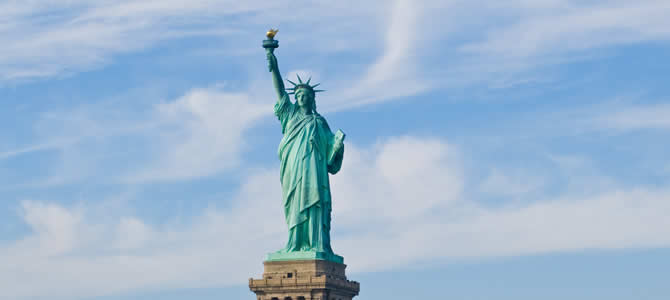STATUE OF LIBERTY, UNITED STATES
T he Statue of Liberty is one of the most renowned symbols of American freedom. It is located on Liberty Island in the middle of the Hudson River in New York City Harbor.
he Statue of Liberty is one of the most renowned symbols of American freedom. It is located on Liberty Island in the middle of the Hudson River in New York City Harbor.
The formal name of the statue is "Liberty Enlightening the World" also known affectionately as "Lady Liberty" has become a symbol of freedom and democracy. The classical appearance derives from Libertas (an ancient Rome's goddess of freedom against oppression and tyranny).
The statue is of a woman holding a torch; it is made of a cover of pure copper, hung on a framework of steel with the exemption of the flame of the torch, which is coated in gold leaf. It stands atop a rectangular stonework pedestal with a base in the shape of an irregular eleven pointed star. The statue is 46 m tall, but with the pedestal and foundation, it is 93 m tall. The face on the Statue of Liberty measures more than 2.4 m. tall. Total weight of the Statue of Liberty is 225 tons.
There are 354 steps inside the statue and its pedestal. There are 25 viewing windows in the crown. The seven rays of Liberty's crown symbolize the seven seas and seven continents of the world. Her torch signifies enlightenment. The tablet in her hand represents knowledge and shows the date of the United States Declaration of Independence, in roman numerals, July IV, MDCCLXXVI. The statue is the central part of Statue of Liberty National Monument, administered by the National Park Service.
History
The Statue of Liberty commemorates the alliance between France and the United States during the American Revolution (1775-1783). It was designed by French sculptor Frédéric-Auguste Bartholdi. The French people donated the money for the statue.
Statue of Liberty, New York
The first model, on a small scale, was built in 1870. This first statue is now in the Jardin du Luxembourg in Paris. A second model, also on a small scale, was further brought to Maceió, a city in the Northeast of Brazil.
Meanwhile in France, Bartholdi required the assistance of an engineer to address structural issues associated with manipulative such a colossal copper sculpture. Gustave Eiffel (designer of the Eiffel Tower) was commissioned to design the enormous iron pylon and secondary skeletal framework which allows the Statue's copper skin to move independently yet stand upright.
On June 30, 1878, at the Paris Exposition, the completed head of the statue was showcased in the garden of the Trocadéro palace, while other pieces were on display in the Champs de Mars.
Back in America, the site, authorized in New York Harbor by an act of Congress, 1877, was selected by General William Tecumseh Sherman, who settled on Bartholdi's own choice, then known as Bedloe's Island (named after Isaac Bedloe), where there was already an early 19th century star-shaped fortification named Fort Wood. United States Minister to France Levi P. Morton hammered the first nail in the construction of the statue.
On February 18, 1879, Bartholdi was granted a design patent, U.S. Patent D11,023, the patent described the head as having "classical, yet severe and calm, features," noted that the body is "thrown slightly over to the left so as to gravitate upon the left leg, the whole figure thus being in equilibrium, manner known to the glyptic art in the form of a statue or statuette, or in alto-relievo or bass-relief, in metal, stone, terra cotta, or other plastic composition". The financing for the statue was completed in France in July 1882.
Statue of Liberty, New York
When the Statue of Liberty was finally ready to be shipped to the United States, problems across the Atlantic emerged. The pedestal on which she would be placed was no where near complete. At last on June 17, 1886, she arrived in New York Harbor, and was officially installed on a massive memorial designed by Richard Morris Hunt, and built with funds raised by newspaper publisher Joseph Pulitzer. To prepare for transit, the Statue was reduced to 350 individual pieces and packed in 214 crates.
Located on Bedloe's Island, renamed Liberty Island in 1956 by an act of Congress, the concrete and granite pedestal was bounded by a star-shaped wall, which was part of Fort Wood, built in the early 19th century to defend New York during the War of 1812.
The statue, which was stored for eleven months in crates waiting for its pedestal to be finished, was then reassembled in four months. On October 28, 1886, the Statue of Liberty was unveiled by President Grover Cleveland in front of thousands of spectators.
In 1924, the statue was established as a national monument and began being managed by the National Park Service from 1933. It was renovated between 1984 and 1986, on account of the statue's 100th birthday. While millions of tourists from different parts of the world visit the Statue of Liberty every year
As with all historic areas administered by the National Park Service, Statue of Liberty National Monument, along with Ellis Island and Liberty Island, was listed on the National Register of Historic Places on October 15, 1966. In 1972, President Richard M. Nixon dedicated the American Museum of Immigration, housed in structural additions to the base of the pedestal on top of what was Fort Wood.
In 1984, the Statue of Liberty was added to the list of World Heritage Sites. In 2007, the Statue of Liberty was one of 20 finalists in a competition to name the New Seven Wonders of the World. The Statue of Liberty soon became an international symbol of freedom, greeting the millions of immigrants and visitors as they entered New York Bay and arrived in the United States.